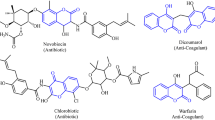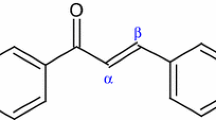Abstract
A series of 3-chloro-1-(5H-dibenz[b,f]azepine-5yl)propan-1-one derivatives (2a–k) bearing different amino acids were synthesized by base condensation reaction. 3-Chloro-1-(5H-dibenz[b,f]azepine-5yl)propan-1-one(2) was obtained by N-acylation of 5H-dibenz[b,f]azepine (1). All the synthesized compounds were evaluated for their potential over antioxidant activities against inhibition of lipid peroxidation by β-carotene and linoleic acid assay and inhibition of human low-density lipoprotein (LDL) oxidation assay. Typically, compound 2 showed weak antioxidant activity, whereas coupling of different amino acids enhances the antioxidant activities based on the presence of different functional groups. Among the derivatives, compound 2d showed significant antioxidant activities followed by 2h, 2i, 2j and 2k.



Similar content being viewed by others
References
Beckman KB, Ames BN (1998) The free radical theory of ageing. Phys Rev 78:447–453
Block G (1992) A role for antioxidants in reducing cancer risk. Nutr Rev 50:207–213
Chirtian Beh L, Moosmann B (2000) Antioxidant neuroprotection in Alzheimer’s disease as preventive and therapeutic approach. Free Rad Biol Med 33:182–191
Fouche J, Leger A (1971) German Patent, 2,031,236; Chem. Abstr. 74:76346r
Frankel EN, Kanner J (1993) Inhibition of oxidation of human low-density lipoprotein by phenolic substances in red wine. Lancet 341:454–457
Halliwel B, Gutteridge JMC (1989) Free radical in biology and medicine. Clarendon Press, Oxford, pp 416–494
Hempel A, Camerman N, Camerman A, Mastropaolo D (2005) Oxcarbazepine: structure and anticonvulsant activity. Acta Cryst E 61:o1313–o1315
Jialal I, Devaraj S (1996) Low-density lipoprotein oxidation, antioxidants, and atherosclerosis: a clinical biochemistry perspective. Clin Chem 42:498–506
Krichka LJ, Ledwith A (1974) Dibenz[b,f]azepines and related ring systems. Chem Rev 74:101–123
Lucarini M, Pedrielli P, Pedulli GF, Valgimigli L, Gigmes D, Toroda P (1999) Bond dissociation energies of the N−H bond and rate constants for the reaction with alkyl, alkoxyl, and peroxyl radicals of phenothiazines and related compounds. J Am Chem Soc 121:11546–11553
Miller HE (1971) A simplified method for the evaluation of antioxidants. J Am Oil Chem Soc 48:91
Moskovitz J, Yim MB, Chock PB (2000) Free radicals and disease. Arch Biochem Biophys 397:354–359
Princen HM, Poppel GV, Vogelezang C, Buytenhek R, Kok FJ (1992) Supplementation with vitamin E but not beta-carotene in vivo protects low density lipoprotein from lipid peroxidation in vitro. Effect of cigarette smoking. Arter Thromb Vasc Biol 12:554–562
Rice-Evans AC, Miller NJ, Paganga G (1996) Structure-antioxidant activity relationships of flavonoids and phenolic acids. Free Rad Biol Med 20:933–956
Steinberg D, Parthasarathy S, Carew TE, Khoo JC, Witztum JL (1989) Beyond cholesterol. Modifications of low-density lipoprotein that increase its atherogenicity. New Engl J Med 320:915–924
Teissedre PL, Waterhouse AL (2000) Inhibition of oxidation of human low-density lipoproteins by phenolic substances in different essential oils varieties. J Agric Food Chem 48:3801–3805
Vijay Kumar H, Gnanendra CR, Channe Gowda D, Naik N (2008) In vitro antioxidant activity of dibenz[b,f]azepine and its analogues. E-J Chem 5(S2):1123–1132
Vinson JA, Dabbagh YA, Serry MM, Jang J (1995) Plant flavonoids, especially tea flavonols, are powerful antioxidants using an in vitro oxidation model for heart disease. J Agric Food Chem 43:2800–2802
Yen GC, Chen HY (1995) Antioxidant activity of various tea extracts in relation to their antimutagenicity. J Agric Food Chem 43:27–32
You-Zhi T, Zai-Qun L (2007) Free-radical-scavenging effect of carbazole derivatives on AAPH-induced hemolysis of human erythrocytes. Bioorg Med Chem 15:1903–1913
Author information
Authors and Affiliations
Corresponding author
Rights and permissions
About this article
Cite this article
Kumar, H.V., Kumar, C.K. & Naik, N. Synthesis of novel 3-chloro-1-(5H-dibenz[b,f]azepine-5yl)propan-1-one derivatives with antioxidant activity. Med Chem Res 20, 101–108 (2011). https://doi.org/10.1007/s00044-009-9292-7
Received:
Accepted:
Published:
Issue Date:
DOI: https://doi.org/10.1007/s00044-009-9292-7




